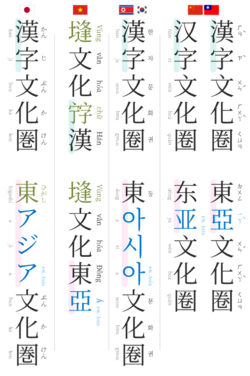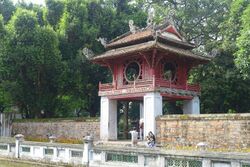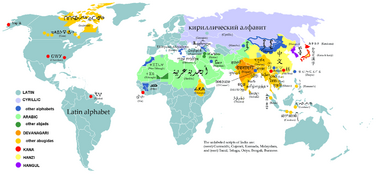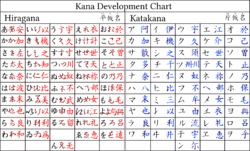Place:East Asian cultural sphere
| East Asian cultural sphere |
|---|
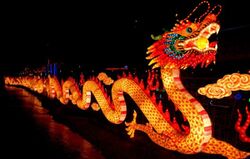
The East Asian cultural sphere, also known as the Sinosphere, the Sinic world, the Sinitic world, the Chinese cultural sphere, or the Chinese character sphere, encompasses multiple countries in East Asia and Southeast Asia that were historically influenced by Chinese culture. The East Asian cultural sphere is made up of several countries and territories: China, Taiwan, Hong Kong, Macau, Japan, South Korea, North Korea, and Vietnam.[1][2] Other definitions sometimes include Mongolia[3][4][5] and Singapore, because of limited historical Chinese influences or increasing modern-day Chinese diaspora.[6] The East Asian cultural sphere is not to be confused with the Sinophone world, which includes countries where the Chinese-speaking population is dominant.[7]
Imperial China was a regional power and exerted influence on tributary states and neighboring states, among which were Japan, Korea, and Vietnam.[lower-alpha 1] These interactions brought ideological and cultural influences rooted in Confucianism, Buddhism, and Taoism. During classical history, the four cultures shared a common imperial system under respective emperors. Chinese inventions influenced, and were in turn influenced by, innovations of the other cultures in governance, philosophy, science, and the arts.[10][11][12] Written Classical Chinese became the regional lingua franca for literary, cultural, scientific and economic exchange,[13] and Chinese characters (Hanzi) became locally adapted in Japan as Kanji, Korea as Hanja, and Vietnam as Chữ Hán.[14][15]
In late classical history, the literary importance of classical Chinese diminished as Japan, Korea, and Vietnam each adopted their own literary device. Japan developed the Katakana and Hiragana scripts, Korea developed Hangul, and Vietnam developed Chữ Nôm (which is now rarely used; the modern Vietnamese alphabet is based on the Latin alphabet).[16][17] Classical literature written in Chinese characters nonetheless remains an important legacy of Japanese, Korean, and Vietnamese cultures.[18] In the 21st century, ideological and cultural influences of Confucianism and Buddhism remain visible in high culture and social doctrines.
Terminology
Ancient China has been regarded as one of the centers of civilization, with the emergent cultures that arose from the migration of original Han settlers from the Yellow River generally regarded as the starting point of the East Asian world. Today its population is approximately 1.402 billion.[19]
Japanese historian Nishijima Sadao (1919–1998), professor emeritus at the University of Tokyo, originally coined the term Tōa bunka-ken (東亜文化圏, 'East Asian Cultural Area'), conceiving of a Chinese or East-Asian cultural sphere distinct from the cultures of the west. According to Nishijima, this cultural sphere—which includes China, Japan, Korea, and Vietnam—shared the philosophy of Confucianism, the religion of Buddhism, and similar political and social structures stemming from a background of historical scholars in Classical Chinese.[20]
Etymology
Sometimes used as a synonym for the East-Asian cultural sphere, the term Sinosphere derives from Sino- ('China, Chinese') and -sphere, in the sense of a sphere of influence (i.e., an area influenced by a country). (cf. Sinophone.)[21]
As cognates of each other, the "CJKV" languages—Chinese, Japanese, Korean, and Vietnamese—translate the English term sphere as:
Victor H. Mair discussed the origins of these "culture sphere" terms.[22] The Chinese wénhuà quān (文化圈) dates back to a 1941 translation for the German term Kulturkreis, ('culture circle, field'), which the Austrian ethnologists Fritz Graebner and Wilhelm Schmidt proposed. Japanese historian Nishijima Sadao coined the expressions Kanji bunka ken (漢字文化圏, "Chinese-character culture sphere") and Chuka bunka ken (中華文化圏, "Chinese culture sphere"), which China later re-borrowed as loanwords. Nishijima devised these Sinitic "cultural spheres" within his Theory of an East Asian World (東アジア世界論 Higashi Ajia sekai-ron).[citation needed]
Chinese–English dictionaries provide similar translations of this keyword wénhuà quān (文化圈) as "the intellectual or literary circles" (Liang Shiqiu 1975) and "literary, educational circles" (Lin Yutang 1972).[citation needed]
The Sinosphere may be taken to be synonymous to Ancient China and its descendant civilizations as well as the "Far Eastern civilizations" (the Mainland and the Japanese ones). In the 1930s in A Study of History, the Sinosphere along with the Western, Islamic, Eastern Orthodox, Indic, etc. civilizations is presented as among the major "units of study."[23]
Comparisons with the West
British historian Arnold J. Toynbee listed the Far Eastern civilization as one of the main civilizations outlined in his book, A Study of History. He included Japan and Korea in his definition of "Far Eastern civilization" and proposed that they grew out of the "Sinic civilization" that originated in the Yellow River basin.[24] Toynbee compared the relationship between the Sinic and Far Eastern civilization with that of the Hellenic and Western civilizations, which had an "apparentation-affiliation."[25]
American Sinologist and historian Edwin O. Reischauer also grouped China, Japan, Korea, and Vietnam into a cultural sphere that he called the Sinic world, a group of centralized states that share a Confucian ethical philosophy. Reischauer states that this culture originated in Northern China, comparing the relationship between Northern China and East Asia to that of Greco-Roman civilization and Europe. The elites of East Asia were tied together through a common written language based on Chinese characters, much in the way that Latin had functioned in Europe.[26]
American political scientist Samuel P. Huntington considered the Sinic world as one of many civilizations in his book The Clash of Civilizations. He notes that "all scholars recognize the existence of either a single distinct Chinese civilization dating back to at least 1500 B.C. and perhaps a thousand years earlier, or of two Chinese civilizations one succeeding the other in the early centuries of the Christian epoch."[27] Huntington's Sinic civilization includes China, North Korea, South Korea, Vietnam and Chinese communities in Southeast Asia.[28] Of the many civilizations that Huntington discusses, the Sinic world is the only one that is based on a cultural, rather than religious, identity.[29] Huntington's theory was that in a post-Cold War world, humanity "[identifies] with cultural groups: tribes, ethnic groups, religious communities [and] at the broadest level, civilizations."[30][31] Yet, Huntington considered Japan as a distinct civilization.[32]
Culture
Arts
- Architecture: Countries from the East Asian cultural sphere (Japan, Korea, Vietnam, Taiwan) share a common architectural style stemming from the architecture of ancient China.[33]
- Calligraphy: Caoshu is a cursive script-style used in Chinese and East Asian calligraphy.[34]
- Cinema: see, Hong Kong cinema, Taiwanese cinema, Chinese cinema, Japanese cinema, Korean cinema, Vietnamese cinema.
- Comic: see, Manga (Japanese comics), Manhua (Chinese comics), Manhwa (Korean comics), Truyện tranh (Vietnamese comics).
- Martial Arts: see, Gōngfu (Kung fu; Chinese Martial Arts); Taekwondo and Hapkido (Korean Martial Arts); Karate, Aikido, Jūdō and Sumo (Japanese Martial Arts); Vovinam and Nhất Nam (Vietnamese Martial Arts).
- Music: Chinese musical instruments, such as erhu, have influenced those of Korea, Japan, Taiwan, and Vietnam.
- Clothing: Hanfu, Hanbok, Việt phục, Wafuku, all use silk and have similar mandarin, soldiers, officials, and emperors/empress traditional clothing. Jade jewelry and ornaments were also highly valued throughout East Asia, South Asia, Southeast Asia, etc.
Cuisine
The cuisine of East Asia shares many of the same ingredients and techniques. Chopsticks are used as an eating utensil in all of the core East Asian countries.[35] The use of soy sauce, which is made from fermenting soybeans, is also widespread in the region.[36]
Rice is the staple food in all of East Asia and is a major focus of food security.[37] People who have no rice are often seen as having no food. Moreover, in East Asian countries such as Japan (御飯; gohan) and Korea (밥; bap), the word for 'cooked rice' can embody the meaning of food in general.[35]
Popular terms associated with East Asian cuisine include boba, kimchi, sushi, hot pot, tea, dim sum, ramen, as well as phở, sashimi, udon, bánh mì among others.[38]
Traditions
- Fashion: see, Hanfu and Cheongsam (or Qipao) (China); Áo dài and Việt phục (Vietnam); Hanbok (Korea); Kimono and Wafuku (Japan).
- Dance: The Lion Dance is a form of traditional dance in Chinese culture and other culturally East Asian countries in which performers mimic a lion's movements in a lion costume to bring good luck and fortune. Aside from China, versions of the lion dance are found in Japan , Korea, Vietnam, Tibet, and Taiwan. Lion Dances are usually performed during Lunar New Year, religious and cultural celebrations.
- New Year: China (Zhōngguó Xīn Nián), Korea (Seollal), Vietnam (Tết Nguyên Đán), Japan (Koshōgatsu), and Taiwan traditionally observe the same Lunar New Year. However, Japan has moved its New Year (Shōgatsu) to fit the Western New Year since the Meiji Restoration.[citation needed] Although mainland Japan may not celebrate the Lunar New Year anymore, there are some indigenous minority ethnic groups in Japan that still do such as the Okinawan/Ryukyuan people. Okinawa has traditionally observed the Lunar New Year because of heavy Chinese influence in its past. Festivities nowadays aren't as elaborate as the Western new year but, Okinawans still celebrate and partake in many traditions for Lunar New Year.[39]
Literature
East-Asian literary culture is based on the use of Literary Chinese, which became the medium of scholarship and government across the region. Although each of these countries developed vernacular writing systems and used them for popular literature, they continued to use Chinese for all formal writing until it was swept away by rising nationalism around the end of the 19th century.[40]
Throughout East Asia, Literary Chinese was the language of administration and scholarship. Although Vietnam, Korea, and Japan each developed writing systems for their languages, these were limited to popular literature. Chinese remained the medium of formal writing until it was displaced by vernacular writing in the late 19th and early 20th centuries.[41] Though they did not use Chinese for spoken communication, each country had its tradition of reading texts aloud, the so-called Sino-Xenic pronunciations, which provide clues to the pronunciation of Middle Chinese. Chinese words with these pronunciations were also borrowed extensively into the local vernaculars, and today comprise over half their vocabularies.[42]
Books in Literary Chinese were widely distributed. By the 7th century and possibly earlier, woodblock printing had been developed in China. At first, it was used only to copy the Buddhist scriptures, but later secular works were also printed. By the 13th century, metal movable type was used by government printers in Korea but seems to have not been extensively used in China, Vietnam, or Japan. At the same time manuscript reproduction remained important until the late 19th century.[43]
Japan's textual scholarship had Chinese origin which made Japan one of the birthplaces of modern Sinology.[44]
Philosophy and religion
The Art of War, Tao Te Ching, I Ching and Analects are classic Chinese texts that have been influential in East Asian history.[45]
Taoism
The countries of China, Korea, Vietnam and Japan have been influenced by Taoism. Developed from Eastern philosophy, known as Tao, the religion was created in China from the teachings of Lao Tse. It follows the search for the tao, a concept that is equivalent to a path or course and represents the cosmic force that creates the universe and all things.
According to this belief, the wisdom of the Tao is the only source of the universe and must be a natural path of life events that everyone should follow. Thus, the adherents of Taoism follow the search for Tao, which means path and represents the strength of the universe.
The most important text in Taoism, the Tao Te Ching (Book of the Way and Virtue, c. 300 BC), declares that the Tao is the "source" of the universe, thus considered a creative principle, but not as a deity. Nature manifests itself spontaneously, without a higher intention, it is up to the human being to integrate, through "non-action" ("wuwei") and spontaneity ("ziran"), to its flow and rhythms, to achieve happiness and a long life.
Taoism is a combination of teachings from various sources, manifesting itself as a system that can be philosophical, religious or ethical. This tradition can also be presented as a worldview and a way of life.
Buddhism
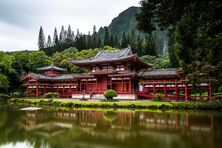
The countries of China, Japan, Korea, and Vietnam share a history of Mahayana Buddhism. It spread from India via the Silk Road through north-west India and modern day Pakistan , Xinjiang, eastward through Southeast Asia, Vietnam, then north through Guangzhou and Fujian. From China, it proliferated to Korea and Japan, especially during the Six Dynasties. It could have also re-spread from China south to Vietnam. East Asia is now home to the largest Buddhist population in the world at around 200–400 million, with the top five countries including China, Thailand, Myanmar, Japan, Vietnam—three of which falling within the East-Asian Cultural Sphere.[citation needed]
Buddhist philosophy is guided by the teachings of the Buddha, which lead the individual to full happiness through meditative practices, mindfulness, and reflection on their daily actions. The belief is that physical and spiritual awareness leads to a state of enlightenment called nirvana, which according to Buddha is the highest state of meditation. In this state the individual finds peace and tranquility above the oscillations of thoughts and emotions, and is rid of the inherent suffering of the physical world.
Confucianism
The countries of China, Japan, Korea, and Vietnam share a Confucian philosophical worldview.[26] Confucianism is a humanistic[46] philosophy that believes that human beings are teachable, improvable and perfectible through personal and communal endeavor especially including self-cultivation and self-creation. Confucianism focuses on the cultivation of virtue and maintenance of ethics, the most basic of which are:[47]
- rén (仁): an obligation of altruism and humaneness for other individuals;
- yì (义/義): the upholding of righteousness and the moral disposition to do good; and
- lǐ (礼/禮): a system of norms and propriety that determines how a person should properly act in everyday life.
Neo-Confucianism
Mid-Imperial Chinese philosophy is primarily defined by the development of Neo-Confucianism. During the Tang dynasty, Buddhism from Nepal also became a prominent philosophical and religious discipline. Neo-Confucianism has its origins in the Tang dynasty; the Confucianist scholar Han Yu is seen as a forebear of the Neo-Confucianists of the Song dynasty.[48] The Song dynasty philosopher Zhou Dunyi is seen as the first true "pioneer" of Neo-Confucianism, using Daoist metaphysics as a framework for his ethical philosophy.[49]
Elsewhere in East Asia, Japanese philosophy began to develop as indigenous Shinto beliefs fused with Buddhism, Confucianism and other schools of Chinese philosophy. Similar to Japan, in Korean philosophy elements of Shamanism were integrated into the Neo-Confucianism imported from China. In Vietnam, neo-Confucianism along with Taoism and Buddhism were also developed into Vietnam's own Tam giáo, which together with Vietnamese folk religion contributed to perfecting Vietnamese philosophy.
Other religions
Though not commonly identified with that of East Asia, the following religions have been influential in its history:[citation needed]
- Hinduism, see Hinduism in Vietnam, Hinduism in China[citation needed]
- Islam is the most popular religion in Xinjiang, and has significant communities in Ningxia. See Islam in China, Islam in Hong Kong, Islam in Japan, Islam in Korea, Islam in Vietnam.[citation needed]
- Christianity is the most popular religion in South Korea and ranks among the most popular in Singapore.[50] Significant Christian communities are also found in China, Hong Kong, Japan, Macau, Taiwan and Vietnam.[51]
Language
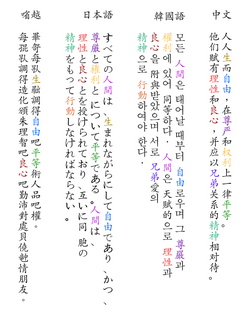
Historical linguistics
Various languages are thought to have originated in East Asia and have various degrees of influence on each other.[citation needed] These include:
- Sino-Tibetan: Spoken mainly in China, Singapore, Myanmar, Christmas Island, Bhutan, Northeast India, Kashmir and parts of Nepal. Major Sino-Tibetan languages include the varieties of Chinese, the Tibetic languages, and Burmese. These are thought to have originated around the Yellow River north of the Yangzi.[52][53]
- Austronesian: Spoken mainly in what is today Taiwan, East Timor, Brunei, Indonesia, the Philippines, Singapore, Malaysia, the Cocos (Keeling) Islands, Christmas Island, Madagascar and most of Oceania. Major Austronesian languages include the Formosan languages, Malay, Filipino, Malagasy, and Māori.[54][55]
- Turkic: Spoken mainly in China, Russia, Turkmenistan, Kyrgyzstan, Uzbekistan, Kazakhstan, Azerbaijan, Iran, Cyprus, and Turkey. Major Turkic languages include Kazakh, Kyrgyz, Uyghur, Tuvan, and Altai.[56][57][58]
- Austroasiatic: Spoken mainly in Vietnam and Cambodia. Major Austroasiatic languages include Vietnamese and Khmer.
- Kra-Dai: Spoken mainly in Thailand, Laos, and parts of Southern China. Major Kra-Dai languages include Zhuang, Thai, and Lao.
- Mongolic: Spoken mainly in Mongolia, China and Russia. Major Mongolian languages include Oirat, Mongolian, Monguor, Dongxiang, and Buryat.
- Tungusic: Spoken mainly in China and Russia. Major Tungusic languages include Evenki, Manchu, and Xibe.
- Koreanic: Spoken mainly in Korea. Major Korean languages include Korean and Jeju.
- Japonic: Spoken mainly in Japan. Major Japonic languages include Japanese, Ryukyuan, and Hachijo.
- Ainu: Spoken mainly in Japan. The only surviving Ainu language is Hokkaido Ainu.
Core languages of the East Asian Cultural Sphere are predominantly Chinese, Japanese, Korean, and Vietnamese, and their respective variants. These are well-documented to have historically used Chinese characters, with Japanese, Korean, and Vietnamese each having roughly 60% of their vocabulary derived from Chinese.[59][60][61] There is a small set of minor languages that are comparable to the core East Asian languages such as Zhuang and Hmong-Mien. They are often overlooked since neither have their own country or heavily export their culture, but Zhuang has been written in Hanzi inspired characters called Sawndip for over 1000 years. Hmong, while having supposedly lacked a writing system until modern history, is also suggested to have a similar percentage of Chinese loans to the core CJKV languages as well.[62]
Despite other languages having been influenced by the Sinosphere such as Thai with its Thai numeral system and Mongolian with its historical use of Hanzi, the amount of Chinese vocabulary overall is not nearly as expansive in these languages as the core CJKV, or even Zhuang and Hmong.[citation needed]
Various hypotheses seek to unify various subsets of the above languages, including the Sino-Austronesian, Altaic, and Austric language groupings. An overview of these various language groups is discussed in Jared Diamond's Germs, Guns, and Steel, and various other places.[citation needed]
Writing systems
East Asia is quite diverse in writing systems, from the Brahmic, inspired abugidas of SEA, the logographic hanzi of China, the syllabaries of Japan, and various alphabets and abjads used in Korea (Hangul), Vietnam (Latin), etc.[citation needed]
| Writing system | Regions |
|---|---|
| Logograms (Hanzi and its variants) | China, Japan, Korea, Malaysia, Singapore, Vietnam*, Taiwan |
| Logograms (Dongba symbols) | China (Used by the Naxi ethnic minorities in China) |
| Syllabary (Kana) | Japan |
| Syllabary (Yi script) | China (Used by the Yi ethnic minorities in China) |
| Semi-syllabary (Bopomofo) | Taiwan and historically Mainland China. (Used to aid in the learning of Hanzi, especially reading and writing, in the elementary schools. In the mainland is used only in the Xiandai Hanyu Cidian) |
| Alphabet (Latin) | Vietnam, China (Used by some ethnic minorities in China, such as the Miao people), Taiwan (Tâi-lô Latin script for Taiwanese Hokkien language) |
| Alphabet (Hangul) | Korea, China (Used by the Choson ethnic minorities in Northeastern China) |
| Alphabet (Cyrillic) | Mongolia (though there is movement to switch back to Mongolian script)[63] |
| Alphabet (Mongolian) | Mongolia*, China (Inner Mongolia) |
| Alphabet (Vietnamese) | Vietnam*, China (Dongxing, Guangxi) still used by the Gin people today |
| Abugida (Brahmic scripts of India n origin) | Singapore, China (Tibet, Xishuangbanna Dai Autonomous Prefecture) |
| Abugida (Pollard script) | China (Used by the Hmong ethnic minorities in China) |
| Abjad (Uyghur Arabic alphabet) | China (Xinjiang) |
| * Official usage historically. Currently used unofficially. | |
Character influences
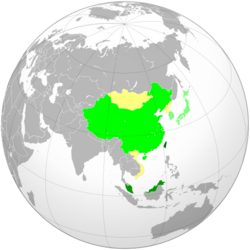
Dark Green: Traditional Chinese used officially (Taiwan, Hong Kong, Macau)
Green: Simplified Chinese used officially but traditional form is also used in publishing (Singapore, Malaysia)[64]
Light Green: Simplified Chinese used officially, traditional form in daily use is uncommon (China, Kokang and Wa State of Myanmar)
Cyan: Chinese characters are used in parallel with other scripts in respective native languages (South Korea, Japan)
Yellow: Chinese characters were once used officially, but this is now obsolete (Mongolia, North Korea, Vietnam)
Hanzi (漢字 or 汉字) is considered the common culture that unifies the languages and cultures of many East Asian nations. Historically, Japan, Korea, and Vietnam have used Chinese characters. Today, they are mainly used in China, Japan, and South Korea albeit in different forms.
Mainland China, Malaysia and Singapore uses simplified characters, whereas Taiwan, Hong Kong, and Macau use Traditional Chinese.
Japan still uses kanji but has also invented kana, inspired by the Chinese cursive script.
Korea used to write in hanja but has invented an alphabetic system called hangul (also inspired by Chinese and phags-pa during the Mongol Empire) that is nowadays the majority script. However, hanja is a required subject in South Korea. Most names are also written in hanja. Hanja is also studied and used in academia, newspapers, and law; areas where a lot of scholarly terms and Sino-Korean loanwords are used and necessary to distinguish between otherwise ambiguous homonyms.
Vietnam used to write in chữ Hán or Classical Chinese. Since the 8th century they began inventing many of their own chữ Nôm. Since French colonization, they have switched to using a modified version of the Latin alphabet called chữ Quốc ngữ. However, Chinese characters still hold a special place in the cultures as their history and literature have been greatly influenced by Chinese characters. In Vietnam (and North Korea), chữ Hán can be seen in temples, cemeteries, and monuments today, as well as serving as decorative motifs in art and design. And there are movements to restore Hán Nôm in Vietnam. (Also see History of writing in Vietnam.)
Zhuang people are similar to the Vietnamese in that they used to write in Sawgun (Chinese characters) and have invented many of their characters called Sawndip (Immature characters or native characters). Sawndip is still used informally and in traditional settings, but in 1957, the People's Republic of China introduced an alphabetical script for the language, which is what it officially promotes.[65]
Economy and trade
Before European imperialism, East Asia has always been one of the largest economies in the world, whose output had mostly been driven by China and the Silk Road.[citation needed] During the Industrial Revolution, East Asia modernized and became an area of economic power starting with the Meiji Restoration in the late 19th century when Japan rapidly transformed itself into the only industrial power outside the North Atlantic area.[66] Japan's early industrial economy reached its height in World War II (1939-1945) when it expanded its empire and became a major world power.[citation needed]
The business cultures within the Sinosphere in some ways are heavily influenced by Chinese culture. Important in China is the social concept of guanxi (關係), which has influenced the societies of Korea, Vietnam and Japan as well.[citation needed] Japan often features hierarchically organized companies, and Japanese work environments place a high value on interpersonal relationships.[67] Korean businesses, adhering to Confucian values, are structured around a patriarchal family governed by filial piety (孝順) between management and a company's employees.[68]
Post-WW2 (Tiger economies)
Following Japanese defeat, economic collapse after the war, and US military occupation, Japan's economy recovered in the 1950s with the post-war economic miracle in which rapid growth propelled the country to become the world's second-largest economy by the 1980s.[citation needed]
After the Korean War, US military occupation following the surrender of Japan in World War 2, and ultimate division of the Korean peninsula, South Korea has experienced its postwar economic miracle called the Miracle on the Han River, with the rise of global tech industry leaders like Samsung, LG, etc. As of 2019 its economy is the 4th largest in Asia and the 11th largest in the world.[citation needed]
Hong Kong became one of the Four Asian Tiger economies, developing strong textile and manufacturing economies.[69] South Korea followed a similar route, developing the textile industry.[69] Following in the footsteps of Hong Kong and Korea, Taiwan and Singapore quickly industrialized through government policies. By 1997, all four of the Asian Tiger economies had joined Japan as economically developed nations.[citation needed]
Since the 1990s Japanese growth has stagnated (see also Lost Decade), and present growth in East Asia has now shifted to China and to the Tiger Cub Economies of Southeast Asia, particularly Vietnam.[70][71][72][73]
Modern era
Since the Chinese economic reform, China has become the 2nd and 1st-largest economy in the world respectively by nominal GDP and GDP (PPP). The Pearl River Delta is one of the top startup regions (comparable with Beijing and Shanghai) in East Asia.[citation needed]
Up until the early 2010s, Vietnamese trade was heavily dependent on China, and many Chinese-Vietnamese speak both Cantonese and Vietnamese, which share many linguistic similarities. Vietnam, one of Next Eleven countries (As of 2005 ), is regarded as a rising economic power in Southeast Asia.[74]
East Asia participates in numerous global economic organizations including:[citation needed]
- Belt and Road Initiative
- Shanghai Cooperation Organization
- ASEAN, ASEAN Plus Three, AFTA
- East Asia Summit
- East Asian Community
- Regional Comprehensive Economic Partnership
See also
- Sinosphere (linguistics)
- China–Vietnam relations
- Adoption of Chinese literary culture
- East Asia
- Sinophone world
- Sino-xenic vocabulary
- Culture of China
- Chinese influence on Korean culture
- Chinese influence on Japanese culture
- Culture of Japan
- Culture of Korea
- Culture of Hong Kong
- Culture of Macau
- Culture of Taiwan
- Ryukyuan culture
- Culture of Vietnam
- Baiyue
- I Ching's influence
- List of tributary states of China
- List of Confucian states and dynasties
- Little China (ideology)
- Pax Sinica
- Four Asian Tigers
- Greater East Asia Co-Prosperity Sphere
- Greater India
- Indosphere
- Greater Iran
- Persianate Society
- Sinicization
- Cultural area
Notes
References
Citations
- ↑ Wang, Edward (2015). Chopsticks: A Cultural and Culinary History. Cambridge University Press. pp. 67–92. doi:10.1017/CBO9781139161855. ISBN 9781139161855.
- ↑ Lowe, Roy; Yasuhara, Yoshihito (2016). "Higher learning in ancient Korea, Japan and Vietnam: The East Asian cultural sphere and the Imperial Chinese". The Origins of Higher Learning. Routledge. ISBN 9781315728551.
- ↑ Billé, Franck; Urbansky, Sören (2018). Yellow Perils: China Narratives in the Contemporary World. p. 173. ISBN 9780824876012. https://books.google.com/books?id=81cEEAAAQBAJ&q=chinese+cultural+sphere+mongolia&pg=PA173.
- ↑ Christian, David (2018). A History of Russia, Central Asia and Mongolia, Volume II: Inner Eurasia from the Mongol Empire to Today, 1260–2000. p. 181. ISBN 9780631210382. https://books.google.com/books?id=EKdFDwAAQBAJ&q=chinese+cultural+sphere+mongolia+david+christian&pg=PA181.
- ↑ Grimshaw-Aagaard, Mark; Walther-Hansen, Mads; Knakkergaard, Martin (2019). The Oxford Handbook of Sound and Imagination: Volume 1. p. 423. ISBN 9780190460167. https://books.google.com/books?id=X26fDwAAQBAJ&q=sinosphere+mongolia&pg=PA423.
- ↑ Gold, Thomas B. (1993). "Go with Your Feelings: Hong Kong and Taiwan Popular Culture in Greater China". The China Quarterly 136 (136): 907–925. doi:10.1017/S0305741000032380. ISSN 0305-7410. https://www.jstor.org/stable/655596.
- ↑ Hee, Wai-Siam (2019). Remapping the Sinophone: The Cultural Production of Chinese-Language Cinema in Singapore and Malaya before and during the Cold War (1 ed.). Hong Kong University Press. doi:10.2307/j.ctvx1hwmg. ISBN 978-988-8528-03-5. https://www.jstor.org/stable/j.ctvx1hwmg.
- ↑ Kang, David C. (2012). East Asia before the West : five centuries of trade and tribute (Paperback ed.). New York: Columbia University Press. ISBN 978-0-231-15319-5. OCLC 794366373.
- ↑ Howe, Christopher. The Origins of Japanese Trade Supremacy: Development and Technology in Asia. p. 337
- ↑ Nanxiu Qian, ed (2020). Rethinking the Sinosphere: Poetics, Aesthetics, and Identity Formation. Cambria Press. ISBN 978-1604979909.
- ↑ Nanxiu Qian, ed (2020). Reexamining the Sinosphere: Cultural Transmissions and Transformations in East Asia. Cambria Press. ISBN 978-1604979879.
- ↑ Jeffrey L. Richey (2013). Confucius in East Asia: Confucianism's History in China, Korea, Japan, and Vietnam. Association for Asian Studies. ISBN 978-0924304736.
- East Asian Confucianism: Interactions and Innovations. Rutgers University. 2010. ISBN 978-0615389325.
- East Asian Confucianisms: Texts in Contexts. National Taiwan University Press and Vandenhoeck & Ruprecht. 2015. ISBN 9783847104087.
- ↑ Denecke, Wiebke; Li, Wai-yee; Tian, Xiaofei (2017) (in en). The Oxford Handbook of Classical Chinese Literature (1000 BCE-900 CE). Oxford University Press. ISBN 978-0-19-935659-1. https://books.google.com/books?id=tO4wDgAAQBAJ&dq=Written+Classical+Chinese+became+the+regional+lingua+franca+for+literary&pg=PA518.
- ↑ Asher, R. E.; Moseley, Christopher (2018-04-19) (in en). Atlas of the World's Languages. Routledge. ISBN 978-1-317-85108-0. https://books.google.com/books?id=R0xWDwAAQBAJ&dq=Chinese+characters+were+adapted+to+local+uses,+and+Japanese+or+Korean+or+Vietnamese&pg=PR187.
- ↑ Lacoste, Véronique; Leimgruber, Jakob; Breyer, Thiemo (2014-10-14) (in en). Indexing Authenticity: Sociolinguistic Perspectives. Walter de Gruyter GmbH & Co KG. ISBN 978-3-11-034701-2. https://books.google.com/books?id=SIHnBQAAQBAJ&dq=Chinese+characters+were+adapted+to+local+uses,+and+Japanese+or+Korean+or+Vietnamese&pg=PA296.
- ↑ Rethinking East Asian Languages, Vernaculars, and Literacies, 1000–1919. Brill. 2014. ISBN 978-9004279278.
- ↑ Pelly, Patricia (2018). "Vietnamese Historical Writing" (in en). The Oxford History of Historical Writing: Volume 5: Historical Writing Since 1945. Oxford University Press. doi:10.1093/oso/9780199225996.003.0028. ISBN 978-0-19-922599-6. https://oxford.universitypressscholarship.com/view/10.1093/oso/9780199225996.001.0001/oso-9780199225996-chapter-28.
- ↑ Takacs, Sarolta (2015-03-04) (in en). The Modern World: Civilizations of Africa, Civilizations of Europe, Civilizations of the Americas, Civilizations of the Middle East and Southwest Asia, Civilizations of Asia and the Pacific. Routledge. ISBN 978-1-317-45572-1. https://books.google.com/books?id=u1TrBgAAQBAJ&dq=Classical+literature+written+in+Chinese+characters+nonetheless+remains+an+important+legacy+of+Japanese,+Korean,+and+Vietnamese+cultures&pg=PA663.
- ↑ Society, National Geographic (2020-09-09). "Huang He Valley" (in en). http://www.nationalgeographic.org/encyclopedia/huang-he-valley/.
- ↑ Wang Hui, "'Modernity and 'Asia' in the Study of Chinese History," in Eckhardt Fuchs, Benedikt Stuchtey, eds.,Across cultural borders: historiography in global perspective [1] (Rowman & Littlefield, 2002 ISBN:978-0-7425-1768-4), p. 322.
- ↑ Handel, Zev (2019-05-07) (in en). Sinography: The Borrowing and Adaptation of the Chinese Script. BRILL. ISBN 978-90-04-35222-3. https://books.google.com/books?id=wTCbDwAAQBAJ&dq=term+Sinosphere&pg=PA10.
- ↑ Victor Mair, Sinophone and Sinosphere, Language Log, November 8, 2012.
- ↑ See the "family tree" of Toynbee's "civilizations" in any edition of Toynbee's work, or e.g. as Fig.1 on p.16 of: The Rhythms of History: A Universal Theory of Civilizations, By Stephen Blaha. Pingree-Hill Publishing, 2002. ISBN:0-9720795-7-2.
- ↑ Sun, Lung-kee (2002). The Chinese National Character: From Nationalhood to Individuality. M.E. Sharpe. p. 154. ISBN 978-0-7656-3936-3. https://books.google.com/books?id=O9_U-XdJ3iYC&pg=PA154.
- ↑ Sun, Lung-kee (2002). The Chinese National Character: From Nationalhood to Individuality. M.E. Sharpe. p. 188. ISBN 978-0-7656-0826-0. https://books.google.com/books?id=0ZgRtzGLG_oC&pg=PA188.
- ↑ 26.0 26.1 Reischauer, Edwin O. (1974). "The Sinic World in Perspective". Foreign Affairs 52 (2): 341–348. doi:10.2307/20038053.
- ↑ The Clash of Civilizations and the Remaking of World Order. (New York: Simon & Schuster, 1996; ISBN:0684811642), p. 45
- ↑ William E. Davis (2006). Peace And Prosperity in an Age of Incivility. University Press of America. p. 197. ISBN 978-0-7618-3248-5. https://books.google.com/books?id=w1okRtHKiLIC&pg=PA197.
- ↑ Michail S. Blinnikov (2011). A Geography of Russia and Its Neighbors. Guilford Press. p. 132. ISBN 978-1-60623-933-9. https://books.google.com/books?id=QcoodEOmnMUC&pg=PA132.
- ↑ Lung-kee Sun (2002). The Chinese National Character: From Nationalhood to Individuality. M.E. Sharpe. p. 32. ISBN 978-0-7656-0826-0. https://books.google.com/books?id=0ZgRtzGLG_oC&pg=PA32.
- ↑ Hugh Gusterson (2004). People of the bomb: portraits of America's nuclear complex. U of Minnesota Press. p. 124. ISBN 978-0-8166-3860-4. https://books.google.com/books?id=iHJRW0GI31MC&pg=PA124.
- ↑ McCormack, Gavan; Field, Norma (2016-07-08) (in en). The Emptiness of Japanese Affluence. Routledge. ISBN 978-1-315-49935-2. https://books.google.com/books?id=CWqlDAAAQBAJ&dq=Huntington+considered+Japan+as+a+distinct+civilization.&pg=PT152.
- ↑ McCannon, John (February 2002). How to Prepare for the AP World History. ISBN 9780764118166. https://books.google.com/books?id=tA_3y2XsMMsC.
- ↑ Pan, Lu (2015-06-22) (in en). Aestheticizing Public Space: Street Visual Politics in East Asian Cities. Intellect Books. ISBN 978-1-78320-453-3. https://books.google.com/books?id=rJbzCQAAQBAJ&dq=Caoshu+is+a+cursive+script-style+used+in+Chinese+and+East+Asian+calligraphy.&pg=PA12.
- ↑ 35.0 35.1 Davidson, Alan (1981). Food in Motion: The Migration of Foodstuffs and Cookery Techniques : Proceedings : Oxford Symposium 1983. Oxford Symposium. p. 22. ISBN 978-0-907325-07-9. https://books.google.com/books?id=zcNdB_sl2JkC&pg=PA22.
- ↑ Katz, Sandor Ellix (2012-05-14) (in en). The Art of Fermentation: New York Times Bestseller. Chelsea Green Publishing. ISBN 978-1-60358-364-0. https://books.google.com/books?id=-zmLa205d0QC&dq=use+of+soy+sauce,+which+is+made+from+fermenting+soybeans,+is+also+widespread+in+east+asia&pg=PA325.
- ↑ Wen S. Chern; Colin A. Carter; Shun-yi Shei (2000). Food security in Asia: economics and policies. Edward Elgar Publishing. p. 2. ISBN 978-1-78254-334-3. https://books.google.com/books?id=zcOmGXTqYWMC&pg=PA2.
- ↑ Kim, Kwang-Ok (2015-02-01). Re-Orienting Cuisine : East Asian Foodways in the Twenty-First Century. Berghahn Books, Incorporated. p. 14. ISBN 9781782385639.
- ↑ "Tradition: Okinawa Lunar New Year Celebration". 20 January 2010. https://travelthruhistory.com/tradition-onikawa-lunar-new-year-celebration/.
- ↑ Kornicki, P.F. (2011), "A transnational approach to East Asian book history", in Chakravorty, Swapan; Gupta, Abhijit, New Word Order: Transnational Themes in Book History, Worldview Publications, pp. 65–79, ISBN 978-81-920651-1-3, https://books.google.com/books?id=bjJBrKfCKIYC&pg=PA65.Kornicki 2011, pp. 75–77
- ↑ Kornicki (2011), pp. 66–67.
- ↑ Miyake (2004), pp. 98–99.
- ↑ Kornicki (2011), p. 68.
- ↑ "Given Japan's strong tradition of Chinese textual scholarship, encouraged further by visits by eminent Chinese scholars since the early twentieth century, Japan has been one of the birthplaces of modern sinology outside China" Early China – A Social and Cultural History, page 11. Cambridge University Press.
- ↑ Willett-Wei, Megan. "30 Books That Changed The Course Of History" (in en-US). https://www.businessinsider.com/books-that-changed-history-2014-12.
- ↑ Juergensmeyer, Mark (2005). Religion in global civil society. Oxford University Press. p. 70. ISBN 978-0-19-518835-6.
- ↑ Craig, Edward. Philosophy: A Very Short Introduction. ISBN:0-19-285421-6 p. 536
- ↑ Essentials of Neo-Confucianism: Eight Major Philosophers of the Song and Ming Periods by Huang, Siu-chi. p. 5
- ↑ Chan 1963, p. 460.
- ↑ "STATISTICS SINGAPORE – Infographic – General Household Survey 2015". https://www.singstat.gov.sg/-/media/files/visualising_data/infographics/ghs/highlights-of-ghs2015.pdf.
- ↑ Analysis (19 December 2011). "Global Christianity". Pew Research Center. http://www.pewforum.org/Christian/Global-Christianity-exec.aspx.
- ↑ Jin, Li; Wuyun Pan; Yan, Shi; Zhang, Menghan (2019-04-24). "Phylogenetic evidence for Sino-Tibetan origin in northern China in the Late Neolithic" (in en). Nature 569 (7754): 112–115. doi:10.1038/s41586-019-1153-z. ISSN 1476-4687. PMID 31019300. Bibcode: 2019Natur.569..112Z.
- ↑ Sagart, Laurent; Jacques, Guillaume; Lai, Yunfan; Ryder, Robin J.; Thouzeau, Valentin; Greenhill, Simon J.; List, Johann-Mattis (2019). "Dated language phylogenies shed light on the ancestry of Sino-Tibetan". Proceedings of the National Academy of Sciences 116 (21): 10317–10322. doi:10.1073/pnas.1817972116. PMID 31061123. Bibcode: 2019PNAS..11610317S.
- ↑ Fox, James (19–20 August 2004). "Current Developments in Comparative Austronesian Studies". Symposium Austronesia, Pascasarjana Linguististik dan Kajian Budaya Universitas Udayana. Bali. OCLC 677432806. https://digitalcollections.anu.edu.au/handle/1885/43158.
- ↑ Trejaut, Jean A; Kivisild, Toomas; Loo, Jun Hun et al. (2005). "Traces of Archaic Mitochondrial Lineages Persist in Austronesian-Speaking Formosan Populations" (in en). PLOS Biology 3 (8): e247. doi:10.1371/journal.pbio.0030247. PMID 15984912.
- ↑ Yunusbayev, Bayazit; Metspalu, Mait; Metspalu, Ene et al. (2015-04-21). "The Genetic Legacy of the Expansion of Turkic-Speaking Nomads across Eurasia". PLOS Genetics 11 (4): e1005068. doi:10.1371/journal.pgen.1005068. ISSN 1553-7390. PMID 25898006. ""Thus, our study provides the first genetic evidence supporting one of the previously hypothesized IAHs to be near Mongolia and South Siberia."".
- ↑ Blench, Roger; Spriggs, Matthew (2003) (in en). Archaeology and Language II: Archaeological Data and Linguistic Hypotheses. Routledge. p. 203. ISBN 9781134828692. https://books.google.com/books?id=48iKiprsRMwC&pg=PA203.
- ↑ "Transeurasian theory: A case of farming/language dispersal". https://www.researchgate.net/publication/320915864.
- ↑ DeFrancis, John (1977). Colonialism and language policy in Viet Nam. The Hague: Mouton. ISBN 9027976430. OCLC 4230408.
- ↑ Sohn, Ho-min. (1999). The Korean language. Cambridge, UK: Cambridge University Press. ISBN 0521361230. OCLC 40200082.
- ↑ Shibatani, Masayoshi. (1990). The languages of Japan. 柴谷, 方良, 1944- (Reprint 1994 ed.). Cambridge [England]: Cambridge University Press. ISBN 0521360706. OCLC 19456186.
- ↑ Ratliff, Martha Susan. (2010). Hmong-Mien language history. Pacific Linguistics. ISBN 9780858836150. OCLC 741956124.
- ↑ "Why reading their own language gives Mongolians a headache" (in en). 2013-09-26. https://soranews24.com/2013/09/27/why-reading-their-own-language-gives-mongolians-a-headache/.
- ↑ 林友順 (June 2009). "大馬華社遊走於簡繁之間" (in zh). Yazhou Zhoukan. https://www.yzzk.com/article/details/%E5%B0%81%E9%9D%A2%E5%B0%88%E9%A1%8C/2009-25/1365566312660/%E5%A4%A7%E9%A6%AC%E8%8F%AF%E7%A4%BE%E9%81%8A%E8%B5%B0%E6%96%BC%E7%B0%A1%E7%B9%81%E4%B9%8B%E9%96%93.
- ↑ Zhou, Minglang (24 October 2012). Multilingualism in China : the politics of writing reforms for minority languages, 1949–2002. Berlin. ISBN 9783110924596. OCLC 868954061.
- ↑ Aiko Ikeo (4 January 2002). Economic Development in Twentieth-Century East Asia: The International Context. Taylor & Francis. p. 12. ISBN 978-0-203-02704-2. https://books.google.com/books?id=4wI02db8VtwC&pg=PA12.
- ↑ Where cultures meet; a cross-cultural comparison of business meeting styles. Hogeschool van Amsterdam. p. 69. ISBN 978-90-79646-17-3. https://books.google.com/books?id=JUyRNpVtt5oC&pg=PA69.
- ↑ Timothy Book; Hy V.. Luong (1999). Culture and economy: the shaping of capitalism in eastern Asia. University of Michigan Press. p. 131. ISBN 978-0-472-08598-9. https://books.google.com/books?id=AR3arRgfltkC&pg=PA131. Retrieved 26 May 2013.
- ↑ 69.0 69.1 Compare: J. James W. Harrington; Barney Warf (1995). Industrial Location: Principles, Practice, and Policy. Routledge. p. 199. ISBN 978-0-415-10479-1. https://books.google.com/books?id=NBKjj5Wq6N0C&pg=PA199. "As the textile industry began to abandon places with high labor costs in the western industrialized world, it began to sprout up in a variety of Third World locations, in particular the famous 'Four Tiger' nations of East Asia: South Korea, Taiwan, Hong Kong, and Singapore. Textiles were particularly important in the early industrialization of South Korea, while garment production was more significant to Hong Kong."
- ↑ "Why South Korea risks following Japan into economic stagnation" (in en). 2018-08-21. https://www.afr.com/news/politics/world/why-south-korea-risks-following-japan-into-economic-stagnation-20180821-h1491c.
- ↑ Abe, Naoki (12 February 2010). "Japan's Shrinking Economy". https://www.brookings.edu/opinions/japans-shrinking-economy/.
- ↑ "The rise and demise of Asia's four little dragons" (in en). 2017-02-28. https://www.scmp.com/comment/insight-opinion/article/2074773/rise-and-demise-asias-four-little-dragons.
- ↑ "YPs' Guide To: Southeast Asia—How Tiger Cubs Are Becoming Rising Tigers". https://spe.org/en/print-article/?art=4508.
- ↑ "The story behind Viet Nam's miracle growth". https://www.weforum.org/agenda/2018/09/how-vietnam-became-an-economic-miracle/.
Sources
- Ankerl, Guy (2000). Coexisting contemporary civilizations : Arabo-Muslim, Bharati, Chinese, and Western. Global communication without universal civilization. 1. Geneva, Switzerland: INU Press. ISBN 978-2-88155-004-1.
- Chan, Wing-tsit (1963), A Sourcebook of Chinese Philosophy, Princeton: Princeton University Press, ISBN 978-0-691-07137-4
- Elman, Benjamin A (2014). Rethinking East Asian Languages, Vernaculars, and Literacies, 1000–1919. Leiden: Brill. ISBN 978-9004279278. https://brill.com/view/title/26299.
- Joshua Fogel, "The Sinic World," in Ainslie Thomas Embree, Carol Gluck, ed., Asia in Western and World History a Guide for Teaching. (Armonk, N.Y.: M.E. Sharpe, Columbia Project on Asia in the Core Curriculum, 1997). ISBN:0585027331. Access may be limited to NetLibrary affiliated libraries. EBSCOhost Login
- Fogel, Joshua A. (2009). Articulating the Sinosphere : Sino-Japanese relations in space and time. Edwin O. Reischauer Lectures ([Online-Ausg.] ed.). Cambridge, Mass.: Harvard University Press. ISBN 978-0-674-03259-0.
- Holcombe, Charles (2011). "Introduction: What is East Asia". A history of East Asia : from the origins of civilization to the twenty-first century (1st published. ed.). Cambridge, England: Cambridge University Press. pp. 1–10. ISBN 978-0521731645. https://books.google.com/books?id=rHeb7wQu0xIC&q=Holcombe+History+of+East+Asia.
- Huang, Chun-chieh (2015). East Asian Confucianisms: Texts in Contexts. Taipei and Göttingen, Germany: National Taiwan University Press and Vandenhoeck & Ruprecht. ISBN 9783847104087.
- Miyake, Marc Hideo (2004). Old Japanese: A Phonetic Reconstruction. RoutledgeCurzon. ISBN 978-0-415-30575-4. https://books.google.com/books?id=k2tX-KFeuaQC&pg=PA98.
- Reischauer, Edwin O. (1974). "The Sinic World in Perspective". Foreign Affairs 52 (2): 341–348. doi:10.2307/20038053.
External links
- Asia for Educators. Weatherhead East Asian Institute, Columbia University.
